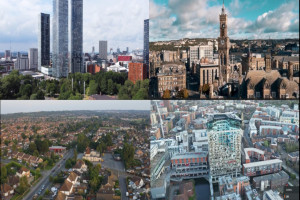The United Kingdom, known for its rich cultural diversity, is home to a significant Muslim population that has grown steadily over the decades. This increase is more pronounced in certain cities, largely due to historical migration patterns, economic opportunities, and community networks. Below, we explore the UK cities with the highest percentage of Muslims, classify them based on these demographics, and discuss the trends expected in the coming decades.
1. Birmingham
Muslim Population Percentage: Approximately 27%
Birmingham, the UK’s second-largest city, boasts one of the highest percentages of Muslims in the country. This large Muslim population is primarily a result of post-war migration, particularly from South Asia (Pakistan and Bangladesh). Over the years, Birmingham has seen a robust growth in its Muslim community, with significant representation in local businesses, education, and politics.
**Future Trends:** Given Birmingham’s youthful population and high birth rates within the Muslim community, the percentage of Muslims is expected to continue to rise. As younger generations increasingly participate in public life, Birmingham’s Muslim influence in cultural and civic spheres will likely expand.
2. Bradford
Muslim Population Percentage: Approximately 25%
Bradford is another city with a high concentration of Muslims, again primarily due to South Asian immigration. Bradford’s textile industry in the mid-20th century attracted many workers from Pakistan, who later settled and established strong community networks. The city has since become a hub for Muslim culture, with a significant number of mosques, Islamic schools, and cultural organizations.
**Future Trends:** The Muslim population in Bradford is expected to remain stable or grow slightly. Urban regeneration projects and education initiatives targeting the city’s youth may further integrate the Muslim community into broader city life while maintaining its distinct cultural identity.
3. Blackburn
Muslim Population Percentage: Approximately 30%
Blackburn, a smaller town in Lancashire, has one of the highest proportions of Muslims in the UK. Similar to Bradford and Birmingham, Blackburn’s Muslim population grew due to immigration from South Asia, particularly during the 1950s and 60s. The town’s Muslim community is tight-knit, with a strong emphasis on preserving religious and cultural traditions.
**Future Trends:** The percentage of Muslims in Blackburn is likely to increase, supported by relatively high birth rates and a strong sense of community cohesion. However, challenges related to economic opportunities and integration may influence future demographic shifts.
4. Luton
Muslim Population Percentage: Approximately 25%
Luton, located just north of London, is known for its diverse population, with Muslims constituting a significant portion. The city’s proximity to the capital has made it a popular location for new immigrants, including Muslims from various parts of the world. Luton’s Muslim community is vibrant, with numerous cultural festivals and Islamic centers contributing to the city’s multicultural fabric.
**Future Trends:** Luton’s Muslim population is expected to continue growing, driven by ongoing migration and natural population growth. The city’s strategic location near London will likely sustain its role as a key hub for Muslim communities in the UK.
5. Leicester
Muslim Population Percentage: Approximately 18%
Leicester is one of the most ethnically diverse cities in the UK, with a significant Muslim population. The city’s diversity is a product of migration from former British colonies, including East Africa and South Asia. Leicester has become a model for multiculturalism, with Muslims playing a prominent role in the city’s economy and politics.
**Future Trends:** Leicester’s Muslim population is likely to see steady growth in the coming decades. The city’s reputation for tolerance and multiculturalism will continue to attract new Muslim residents, ensuring that the community remains a vital part of Leicester’s social and economic life.
6. Manchester
Muslim Population Percentage: Approximately 16%
Manchester, a major urban center in the North of England, has a substantial Muslim population. The city’s universities, economic opportunities, and cultural appeal have attracted Muslims from both within the UK and abroad. Manchester’s Muslim community is diverse, with representation from South Asia, the Middle East, and Africa.
**Future Trends:** Manchester’s Muslim population is expected to grow, driven by continued migration and internal demographic trends. The city’s role as a cultural and economic powerhouse in the North will likely make it a focal point for future Muslim settlement.
**Factors Influencing the Growth of Muslim Populations**
Several factors contribute to the growth of Muslim populations in these cities:
1. **Migration Patterns:** Historical migration, especially from South Asia, the Middle East, and Africa, has established strong Muslim communities in these cities. Family reunification and asylum seekers continue to influence these demographics.
2. **Birth Rates:** Higher birth rates among Muslim families compared to the national average contribute to the growing percentage of Muslims in these cities.
3. **Community Networks:** Strong community networks help new arrivals integrate and settle, reinforcing the concentration of Muslims in these areas.
4. **Economic Opportunities:** Cities like Birmingham and Manchester offer economic opportunities that attract both domestic and international migrants, including Muslims.
**Future Trends and Projections**
Looking ahead, several trends are likely to shape the Muslim population in the UK:
1. **Urban Concentration:** The tendency for Muslims to settle in urban areas with established communities will persist. Cities like Birmingham, Manchester, and London (not covered in this article) will continue to be key hubs.
2. **Integration and Influence:** As younger generations of Muslims enter higher education and the workforce, their influence in politics, culture, and the economy is expected to grow. This will likely lead to more representation in local and national governance.
3. **Social Dynamics:** While the Muslim population is expected to grow, issues related to integration, social cohesion, and economic inequality may pose challenges. Addressing these issues will be critical for ensuring that growth is beneficial for both Muslim communities and broader society.
4. **Diversity within the Muslim Population:** The UK’s Muslim population is increasingly diverse, with growing representation from Middle Eastern and African countries, in addition to the historically dominant South Asian communities. This diversity will add new dimensions to the cultural and religious landscape of UK cities.
Conclusion
The growth of the Muslim population in the UK, particularly in cities like Birmingham, Bradford, and Blackburn, is a significant demographic trend that is reshaping the social and cultural fabric of the country. As these communities continue to grow and evolve, they will play an increasingly important role in the UK’s future. Managing this growth with a focus on integration, social harmony, and economic opportunity will be essential in the coming decades.



